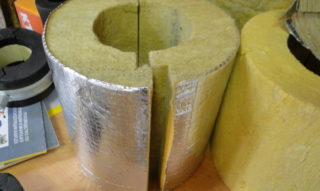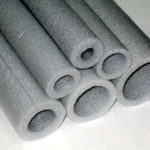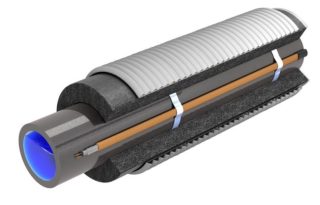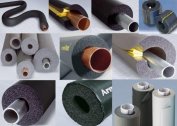A sharp drop in temperature in winter can lead to the formation of an ice plug in the external sewage system. It is very difficult to warm it up, so experts advise using insulation for sewer pipes when installing communications. When choosing a material, its characteristics, service life and installation features are taken into account. Thermal insulation of utility networks in a private house occurs at the construction stage. The process does not require special knowledge, so you can do it yourself.
Insulation Requirements

When choosing a heat insulator, it must be taken into account that it will be under the negative influence of the environment for a long time. So that during operation the material does not lose performance, it must meet certain requirements:
- Resistance to moisture - the material will be regularly exposed to water entering the soil.
- Thermal conductivity - a low value of the parameter indicates the reliability of the insulation.
- Resistance to loads - the insulation puts pressure and mechanical action on the soil, and it should not be torn, covered with cracks.
- Ease of installation - the material is often laid with your own hands, the work must go quickly, without the use of special tools.
- Chemical inertness - the heat insulator is operated in soil, which is an aggressive environment. Chemicals that increase the acid and alkaline levels fall into the earth.
- Flammability - the criterion increases the safety of the sewer system.
- Democratic cost - the cost of insulation should be available to a wide range of buyers.
A good heat insulator will protect the pipes from the effects of frost. Before buying, it is worth examining the product, checking the certificates and the appearance of the products. Mineral wool insulation should have a dense fibrous structure, foamed polyethylene air cells of the same size. The material should not be torn and damaged with a small impact on it.
Types of insulation for sewer pipes
In the market for construction products, a large selection of materials that meet the listed criteria. They can be divided into several large groups: bulk, rolled, shell. Each insulation has characteristic installation features: roll insulation must be cut into separate sheets and fastened with clamps, the shell is sealed with tape.
Mineral wool
Fibrous insulation is made by processing rocks or slag. The cheapest option is glass wool, which is made from glass battle. Stone or basalt wool is resistant to high and low temperatures, its thermal conductivity is only 0.035-0.039 W / m * K. The material is characterized by low hygroscopicity, but when it is in damp, it accumulates moisture. Mineral insulation is not afraid of mold and fungus, does not burn, is resistant to chemicals.
The use of mineral wool with foil coating partially protects the fibers from getting wet and extends the life of the material. The heat insulator is in rolls and molded cylinders. Material thickness 50-150 mm. Rigid cylinders covered with foil or fiberglass are the most convenient option for thermal insulation.They are put on the pipe through a special cut. After sealing, the fibers will be protected from moisture. Installation takes place in a short time.
Cons Insulation:
- when wet, heat loss increases;
- slag wool contributes to the formation of corrosion on metal pipes;
- over the years, the material cakes, cold bridges form.
The material is affordable and easy to use, therefore it is popular as a thermal insulation of sewers.
Foamed polyethylene
The disadvantages of the material include:
- destruction by ultraviolet radiation;
- the need to wind several layers due to the small thickness;
- low resistance to load.
Foamed polyethylene is recommended for insulation of sewers located in unheated rooms.
Expanded polystyrene
Polyfoam for pipe insulation is offered in the form of a shell. The product consists of two halves having a castle connection. The material has high rigidity and density.

Its diameter is from 17 mm and above. For pipes with a large cross section, a shell is made up of 4-8 elements. Positive characteristics of the heat insulator:
- low thermal conductivity;
- affordable cost;
- moisture resistance;
- simple installation;
- biological and chemical inertness;
- service life up to 50 years.
Penoplex has similar properties. Heaters are made from the same raw material, but foam is stronger and denser than polystyrene. It is resistant to deformation and will last a long time. The disadvantage of insulation is sensitivity to mechanical stress. For reinforcement, the cylinders are coated on the outside with fiberglass and protected with a plastic film. Also disadvantages include shell stiffness, it can only be used on flat areas.
Polyurethane foam
According to the technical characteristics, a foam polyurethane insulation is considered one of the best. It has the lowest coefficient of thermal conductivity, does not absorb moisture, and is resistant to aggressive environments and biological effects. Polyurethane foam is operated under any climatic conditions, withstands significant loads.
It is applied to the pipes in liquid form using a special installation or use a molding shell. Half cylinders are connected by transverse and longitudinal locks. To further protect the shell from the negative effects of the soil, it is covered with polyethylene or placed in a galvanized casing.
Rubber
Foamed rubber is a new generation of insulation with excellent heat-shielding characteristics. The elastic material goes on sale in the form of rolls or cylinders. It is biologically sustainable and environmentally friendly.
Raw materials for it are natural and combined rubber. Due to its flexibility, the elastomer with a porous structure fits snugly to the pipes, providing reliable thermal insulation.
The thickness of the insulation in the form of tubes is 6-32 mm, it is focused on products with a cross-section of 6-114 mm. There are two ways to fix the insulation on the sewer:
- weld;
- sticky strip at the junction.
Rubber is durable, does not support combustion, can be operated at -200 ° C. The downside of the heat insulator is the high cost.
Expanded clay
The easiest way to protect communications from freezing in the winter is to fill them with expanded clay. This is a porous building material obtained by firing clay. The thermal insulation properties of natural backfill are often used when laying utility networks. One of the important advantages is the low price of expanded clay. The disadvantage of this method is the sensitivity of the material to moisture. After getting wet, it loses its properties.The filling insulation in the trench is isolated from water using special membranes. The canvas spreads to the bottom, closes the walls of the pit and expanded clay from the top with an overlap. Work on the thermal insulation of sewers is carried out in dry weather.
Heat insulating paint
Special energy-saving paint composition includes microspheres made of perlite, ceramic or foam glass. In addition to vacuum spheres, there is an acrylic or latex binder. Manufacturers claim that a paint layer of 2-4 mm replaces 50 mm of mineral wool. The composition is applied to the surface of the pipes, forming an elastic waterproof coating. It is resistant to temperature changes, serves 20-40 years. Paint is applied by roller or spray. If damaged, the layer is easily restored.
- Expanded clay
- Heat insulating paint
DIY installation steps for thermal insulation
Depending on the chosen method, the thermal insulation process takes place simultaneously with the installation of the pipeline or after its installation. Work begins with the preparation of a trench with a depth of 50 cm and more. Before insulating plastic sewer pipes in the ground, it is necessary to pour a pillow of sand. The technology of laying the insulation depends on its shape. Products can be divided into several groups:
- Roll - mineral wool in mats is mounted in several stages. Previously, the pipe is glued with spiral tape in spirals. Then it is wrapped with insulation, adjacent sheets are laid with an overlap of 15-20 cm. Above the cotton wool is fastened with clamps and scotch tape. Experts recommend closing the insulation with roofing material for waterproofing.
- Shell - hard components have locks for fixing, but for tightness the joints are coated with glue. If a detachable connection is required, improvised materials are used for fastening parts - wire, metal tapes. Products coated with aluminum foil are glued with foil tape.
- Mineral wool cylinders have a longitudinal section for putting on the pipe. When laying basalt or glass wool, the components are pressed tightly against each other. The cylinders are fixed with plastic or metal clamps. If the insulation is covered with foil from the outside, use aluminum tape.
- Foamed polyethylene cylinders are put on after the final installation of the sewer. They can be cut and without. In the second case, the material is cut independently. All joints of the insulation must be glued with construction tape. Rubber cylinders have adhesive strips covered with paper at the cut point. After installation, the strips are removed, the edges of the insulation are compressed with each other.
- Roll insulation
- Shell
- Mineral wool cylinder
- PE foam cylinder
Insulation of pipes with any material should be carried out in dry weather. This will avoid getting wet metal communications and heat insulator.
Features of insulation of sewer pipes in a private house
An external communication network connects the internal sewerage of a residential building with a place for receiving sewage (septic tank, drain pit). To protect it from freezing, it is necessary to observe the installation rules of engineering systems:
- The laying of the sewer pipeline is carried out at a depth below the freezing point of the soil in the region.
- An important factor is compliance with the angle of inclination of 15-20 mm per 1 linear meter. Drains should move to the septic tank without delay.
- Thermal insulation of pipes begins from the place of withdrawal of sewers from the house. A hole is made in the foundation or lower part of the wall that exceeds the diameter of the pipeline. The free space is filled with insulation and sealed.
- Installation of external sewage is carried out by pipes with a cross section of at least 110 mm. The material for them is cast iron, asbestos cement, ceramics. The most common option is plastic.PVC sewage system is resistant to corrosion, durable, not prone to blockages, easy to install.
- When installing a sewer line, it is necessary to minimize the number of turns.
If it is impossible to deepen into the ground pipes that discharge drains, combined insulation is used. The system includes a heating cable that provides the plus temperature of the utility network. A thermal insulation layer is mounted on top of the electric heating element to avoid energy loss.
Thermal insulation of engineering systems in a private house eliminates the problems with their operation in the winter. When installing an external sewage system, it is important to follow the installation rules and choose the right type of insulation.













